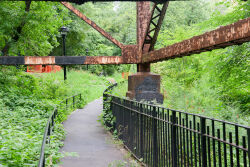West Farms Rapids
Bronx River
The glad spring gushing from the rock’s bare bosom
Sweet sights, sweet sounds, all sights, all sounds excelling
Oh! ‘twas a ravishing spot formed for a poet’s dwelling.
Joseph Rodman Drake (1795-1820), a physician and pharmacist by trade but a poet by passion, lyrically described the Bronx River in his 1817 poem Bronx. Drake spent much of his free time rowing the waters of the Bronx River and writing of the bucolic pleasures he found here and in the surrounding countryside. He came from a prominent Westchester family, but when he died of consumption at age 25, relatives honored his request not to be buried in the family vault. Instead, the “Poet of the Bronx” was laid to rest in a Hunts Point cemetery, near his beloved river.
The river’s story began more than 150 million years ago when a waterway, whose origins lie in present day Westchester County, began carving a channel for itself through the bedrock on its way toward the Bronx. Geologists believe that the Bronx River once emptied into the Hudson River, which lay to the east of its present location. A huge ice mass blocked the Bronx River’s flow during the last Ice Age and forced it to cut a new channel. The Bronx River created a deep gorge before finally emptying out into the East River and Long Island Sound. This striking gorge, most visible as the river travels past the New York Botanical Garden, inspired the Native Americans who lived along the river to name it Aquehung or “River of High Bluffs.”
These local Native Americans, the Weckquaesgeek and Siwanoy, were Algonquin-speaking people whose lives were intertwined with the river for centuries. The river held spiritual significance for them, and they used its water for annual ritual baths. On a daily basis they drank its water, fished along its banks, and hunted in the thick woods beyond its shoreline. Game was plentiful, particularly a large presence of dam-building beavers in the surrounding area. The Siwanoy called the river valley “Laaphawachking” or “Place of Stringing Beads.”
It was the river’s beavers and other economic opportunities, not the lyrical qualities that originally lured Europeans to these shores. Indeed the first shipment of pelts the Dutch trappers sent home in the early 17th century included over 7,000 beaver skins but the European demand for the pelts of beavers, otters, mink, and wildcats soon outpaced the supply, and early settlers searched for other financial opportunities along the river.
In 1639, a wealthy Swedish businessman and former sea captain named Jonas Bronck (1600-1643) became one of the first Europeans to settle in the area when he purchased and bartered 500 acres of land along the river’s southern end from the Native Americans. Bronck farmed the land and soon European settlement spread northward along the waterway that had come to be known as “Bronck’s River.” The first mills in the area started operating in 1680 and by the mid-18th century there were over a dozen being powered by the river, manufacturing everything from barrels and bleach, to ironwork and snuff.
Improved rail access and increasing prosperity along the river brought increased pollution. By the early 1900s, the river that only 60 years earlier had been considered a source of pure drinking water for New York City was being described as an “open sewer” forcing the first efforts toward its conservation. Cycles of renewal and neglect continued for the next 50 years, and the expansion of the Bronx River Parkway in the 1950s further threatened the river.
In 1974, a small band of community activists formed Bronx River Restoration and began the arduous process of cleaning up and restoring the river. Their effort gained strength and numbers in 1997 when Partnerships for Parks convened the Bronx River Working Group and brought together more than 60 community organizations, public agencies, and businesses committed to reclaiming the river and improving access to it throughout the Bronx.
Efforts to restore the Bronx River took a tremendous step forward in 2001 when community leaders and NYC Parks formed the the Bronx River Alliance as a permanent 501(c)(3) organization to continue this work for the long term in partnership with Parks.
The Bronx River Alliance acts as a coordinated voice for the river. The organization works collaboratively with public and private partners to protect, improve, and restore the Bronx River corridor and greenway so that they can be healthy ecological, recreational, educational, and economic resources for the Bronx communities through which the river flows.
Check out your park's Vital Signs
Clean & Safe
Green & Resilient
Empowered & Engaged Users
Share your feedback or learn more about how this park is part of a
Vital Park System










